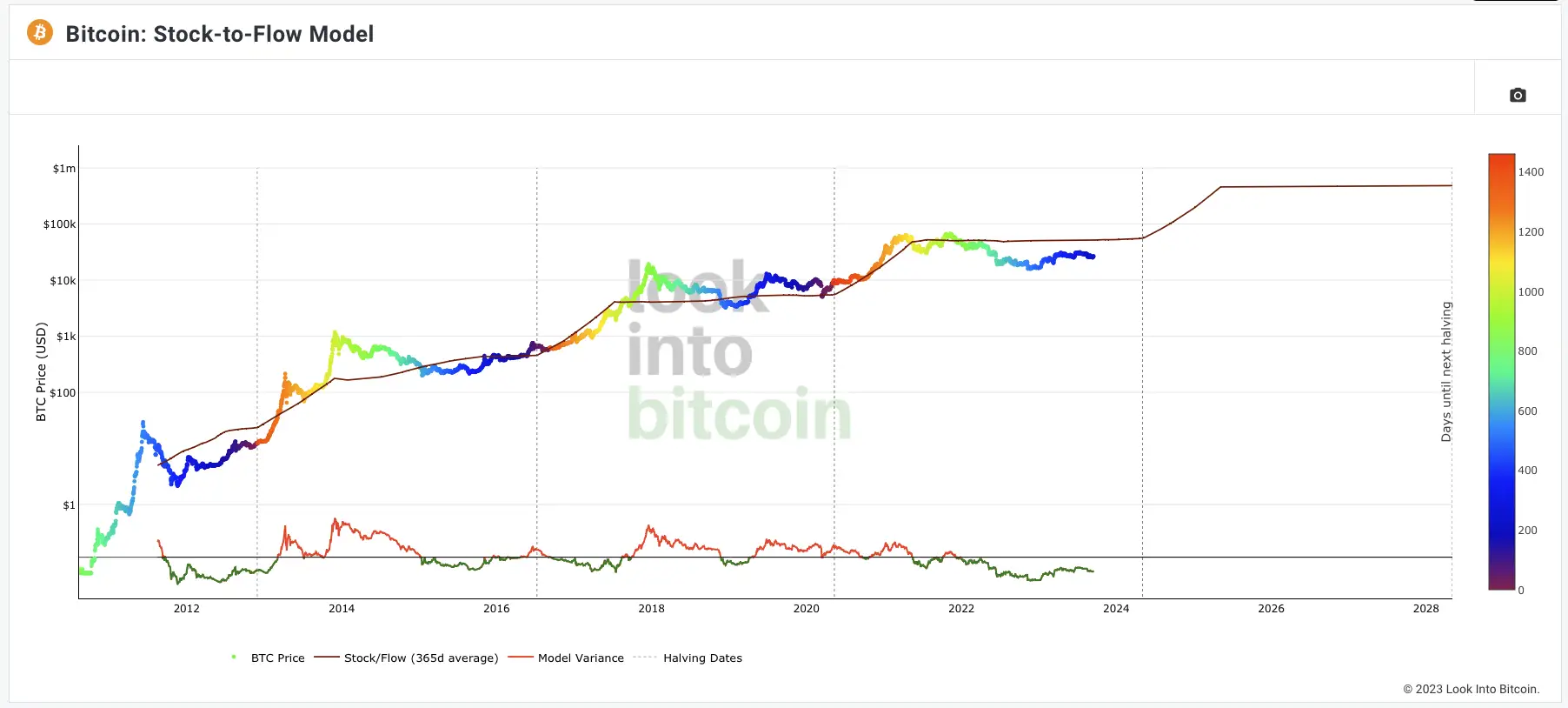- Discover the intricacies of the Stock-to-Flow (S2F) model in predicting Bitcoin’s price movements.
- Explore the historical intersections of Bitcoin price and the S2F model line.
- Understand the potential implications of the current relationship between Bitcoin’s price and the S2F model as of September 16, 2023.
A comprehensive analysis of the Stock-to-Flow model and its implications on Bitcoin’s price trajectory, offering a deep dive into past patterns and current market conditions.
The Pinnacle of Forecasting Tools: Understanding the Stock-to-Flow Model
The Stock-to-Flow (S2F) model has emerged as an invaluable tool for predicting Bitcoin’s price based on its scarcity dynamics. It operates by forecasting price levels using a ratio that compares the total amount of Bitcoin currently available in the market to the number being mined each year. This predictive tool has proven to be remarkably accurate, with historical data showcasing several instances where the Bitcoin price has intersected with the S2F model line, indicating critical buying and selling opportunities for investors.
A Journey Through Time: Notable Intersections of Bitcoin Price and S2F Model

Over the past 12 years, Bitcoin’s price has intersected with the S2F model line at various pivotal points, signaling shifts in market dynamics and trends. These intersections have been landmarks of significant market movements, from bullish runs to bearish phases. Notable intersections include November 2012 and January 2015, when the price crossed below the S2F line, followed by prolonged bull and bear markets, respectively. The more recent crossings in October 2020 and May 2022 have also indicated substantial shifts, presenting opportunities for keen investors to capitalize on potential market trends.
Bitcoin Price and Stock-to-Flow Model Intersections
Bitcoin price has crossed the S2F model line several times over the past 12 years. Here are some of the most notable intersections:
- November 2012: Bitcoin price crossed below the S2F model line. Bitcoin then experienced a parabolic bull run, peaking above $1,100 in November 2013.
- January 2015: Bitcoin price crossed below the S2F model line. Bitcoin then remained in a bear market for the next two years.
- September 2017: Bitcoin price crossed above the S2F model line. Bitcoin then experienced a parabolic bull run, peaking above $20,000 in December 2017.
- December 2018: Bitcoin price crossed below the S2F model line. Bitcoin then remained in a bear market for the next two years.
- October 2020: Bitcoin price crossed above the S2F model line. Bitcoin then experienced a parabolic bull run, peaking above $69,000 in November 2021.
- May 2022: Bitcoin price crossed below the S2F model line. Bitcoin has remained below the S2F model line ever since.
Current Relationship Between Bitcoin Price and Stock-to-Flow Model
As of September 16, 2023, Bitcoin price is trading below the S2F model line. This suggests that Bitcoin may be undervalued on a historical basis.
Market Insights: The Current Landscape of Bitcoin’s Price and S2F Model
As of September 16, 2023, a critical analysis reveals that Bitcoin is trading below the S2F model line, suggesting a potential undervaluation based on historical patterns. This current relationship between the Bitcoin price and the S2F model might be hinting at a golden opportunity for investors seeking to enter the market or expand their portfolios, as it may signify a forthcoming correction in the price trajectory, aligning with the predictions made by the S2F model.
Delving Deeper: Additional Factors Influencing Investment Decisions
While the S2F model serves as a robust forecasting tool, investors should consider a plethora of other factors when making investment decisions. It is paramount to undertake a comprehensive analysis which encompasses a variety of aspects, including fundamental analysis that evaluates underlying factors like network adoption, hashrate, and on-chain metrics, as well as technical analysis that uses indicators to identify patterns in price and trading volume. These analyses offer a more rounded view of the market, enabling informed investment decisions.
Conclusion
In conclusion, the Stock-to-Flow model presents itself as a powerful tool in identifying potential buying and selling opportunities in the volatile cryptocurrency market, particularly for Bitcoin. However, it is essential to note that no technical indicator is infallible and should be used in conjunction with other analytical methods. As the market progresses, investors need to stay abreast with various metrics and analyses, ensuring a well-rounded approach to their investment strategies. Moreover, it is always recommended to conduct thorough research before making any investment decisions, and to consider this analysis as a piece of the larger investment puzzle rather than a standalone guide.
